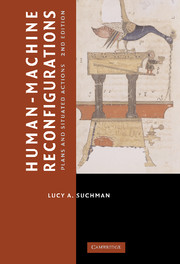Book contents
- Frontmatter
- Contents
- Acknowledgments
- Preface to the 2nd Edition
- Introduction
- 1 Readings and Responses
- 2 Preface to the 1st Edition
- 3 Introduction to the 1st Edition
- 4 Interactive Artifacts
- 5 Plans
- 6 Situated Actions
- 7 Communicative Resources
- 8 Case and Methods
- 9 Human–Machine Communication
- 10 Conclusion to the 1st Edition
- 11 Plans, Scripts, and Other Ordering Devices
- 12 Agencies at the Interface
- 13 Figuring the Human in AI and Robotics
- 14 Demystifications and Reenchantments of the Humanlike Machine
- 15 Reconfigurations
- References
- Index
13 - Figuring the Human in AI and Robotics
Published online by Cambridge University Press: 05 June 2012
- Frontmatter
- Contents
- Acknowledgments
- Preface to the 2nd Edition
- Introduction
- 1 Readings and Responses
- 2 Preface to the 1st Edition
- 3 Introduction to the 1st Edition
- 4 Interactive Artifacts
- 5 Plans
- 6 Situated Actions
- 7 Communicative Resources
- 8 Case and Methods
- 9 Human–Machine Communication
- 10 Conclusion to the 1st Edition
- 11 Plans, Scripts, and Other Ordering Devices
- 12 Agencies at the Interface
- 13 Figuring the Human in AI and Robotics
- 14 Demystifications and Reenchantments of the Humanlike Machine
- 15 Reconfigurations
- References
- Index
Summary
Among the range of projects underway in contemporary artificial intelligence and robotics research. my interest in this chapter is focused on those initiatives aimed most explicitly at the creation of machines that are humanlike. Just what it means to be humanlike, and how the boundary between humans and nonhumans is correspondingly drawn and redrawn, is of course one of the matters in question. A central premise of this book is that projects in AI and robotics involve a kind of doubling or mimicry in the machine that works as a powerful disclosing agent for assumptions about the human. Positioned as exemplary of leading-edge thinking and technical practice, these initiatives in new technology materialize the cultural imaginaries that inspire them and which they work in turn to enact. In the case of AI and robotics, those imaginaries concern the category of the human, on the one hand, and questions of sameness and difference across (and within) the categories of humans, animals, and machines, on the other. One line of generative critique, therefore, is to trace out ways in which the assumptions that underwrite contemporary efforts to configure humanlike machines are remarkably familiar ones, their positioning at the leading edge of technoscientific innovation notwithstanding.
As a methodological strategy, I adopt a focus developed most explicitly within recent feminist and cultural studies of science; that is, an attention to questions of figuration. Figuration has been discussed perhaps most famously by cultural historian of science Donna Haraway (1997: 11).
- Type
- Chapter
- Information
- Human-Machine ReconfigurationsPlans and Situated Actions, pp. 226 - 240Publisher: Cambridge University PressPrint publication year: 2006

